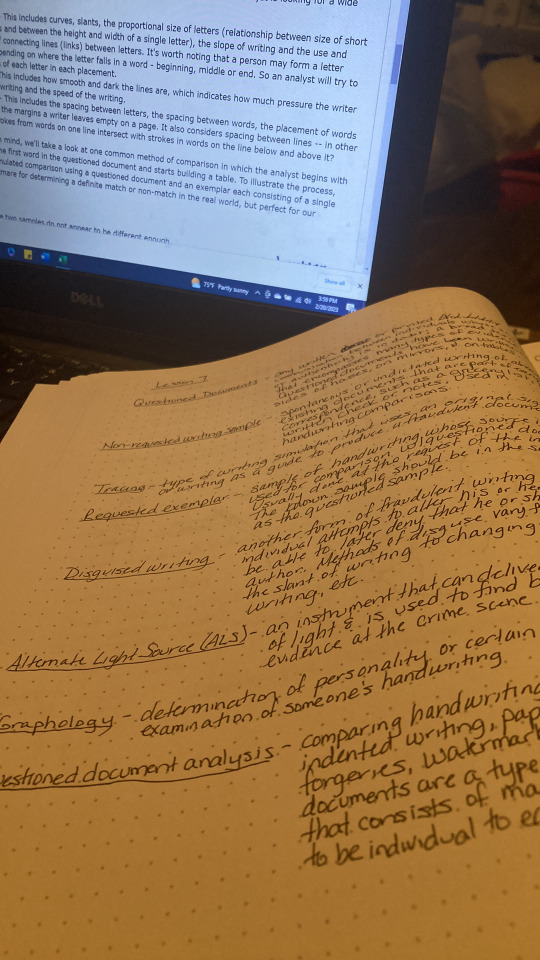Forensic Science Study Session Today. I’m Learning About Questions Documents And Handwriting Analysis.

Forensic science study session today. I’m learning about questions documents and handwriting analysis. If my eyes weren’t so terrible, I might consider this as a career. I’ve always been fascinated by handwriting.
More Posts from Lyliana1277 and Others
Tell me representaron doesn’t matter
Source ~ TikTok @/thewokemama
This has made my heart so so so damn warm. 😭❤️❤️❤️❤️❤️❤️❤️❤️❤️❤️❤️❤️❤️❤️❤️❤️❤️❤️❤️❤️❤️❤️
It’s been a crazy week. My wife has had 3 blood transfusions in the last week, one before surgery, 2 units during her hysterectomy, and one after surgery. She’s still really anemic and her hematocrit is really low still, but she’s home from the hospital.
She and the rest of the family are also getting over RSV. Only 2 of the 7 of us escaped it somehow. Or I had a really mild case right after a cold. Who knows.
I just started back at school and I have a really full semester, taking 14 credits and one class is an honors class. I may regret doing it this way, but I’m excited to finish my degree finally. It took 19 years, with a huge gap between, but I’ll finally have my associates. I’m still unsure about going for my bachelors and trying to figure out what I’d want to major in. That is too overwhelming right now.
So things seem to be looking up for us, once everyone gets over RSV. Fingers crossed my wife’s disability gets approved and my husband gets over his writer’s block. I think addressing his mental health would help, but he’s the type to ignore things until the last minute. We’ll get there.
I struggle with asking questions in class because of all of this.
why autistic/adhd people may not ask for help
i’m not sure where to start and i don’t even know what questions to ask that would help me understand any of this
i want to ask you but i’m deathly afraid that you will hate my guts and resent me forever
i feel stupid and embarrassed for not knowing/understanding this
i wasn’t paying attention/i zoned out/you were talking too fast while going over this
“oh my god are you serious? it’s obvious, weren’t you paying any attention?” thanks for confirming i’m as stupid as i feel, appreciate it
i forgot about this deadline and i should’ve done it sooner but now it’s too late and awkward to say anything
your criticism will cast me into despair
i have no idea how to articulate my concerns so i will sit here silently until i can
i feel horrible about not doing it and not asking you initially and so i’m avoiding talking about it in the hopes that i will miraculously and suddenly understand it instead of doing the walk of shame to your office and risking the chance that i’ll piss you off and ruin your night
i’m working up the confidence to ask you
i’m formulating in my head a way to ask that doesn’t make me sound like i didn’t care enough to do it sooner, and that i actually have the willingness to do it, and that doesn’t place any blame on anyone except maybe me
autistic/adhd people feel free to add on! obviously this will vary from person to person, but this is my personal experience as an autistic and adhd person. if you’re neurotypical, please don’t try to offer tips for how to get around this because i can almost guarantee it will not be helpful :)
The saga continues! Today my wife was supposed to get set up for an ambulatory EEG. The woman came out to set it up, but our outlets are too old and can’t accommodate the equipment. Her neurologist is now setting up a 72 hour EEG hospital stay.
At least our lives are never dull.
source
nobody:
my autistic dad:

Valid
Worst types of country songs:
Alcoholism rules
God bless the USA
Truck
Diet christian music
Love a small town blue eyed girl
Best types of country songs:
Just a specific ass situation
I hate this damn job
Woman kills those who've wronged her
Alcoholism sucks

Infrared is Beautiful
Why was James Webb Space Telescope designed to observe infrared light? How can its images hope to compare to those taken by the (primarily) visible-light Hubble Space Telescope? The short answer is that Webb will absolutely capture beautiful images of the universe, even if it won’t see exactly what Hubble sees. (Spoiler: It will see a lot of things even better.)

The James Webb Space Telescope, or Webb, is our upcoming infrared space observatory, which will launch in 2019. It will spy the first luminous objects that formed in the universe and shed light on how galaxies evolve, how stars and planetary systems are born, and how life could form on other planets.
What is infrared light?
This may surprise you, but your remote control uses light waves just beyond the visible spectrum of light—infrared light waves—to change channels on your TV.
Infrared light shows us how hot things are. It can also show us how cold things are. But it all has to do with heat. Since the primary source of infrared radiation is heat or thermal radiation, any object that has a temperature radiates in the infrared. Even objects that we think of as being very cold, such as an ice cube, emit infrared.
There are legitimate scientific reasons for Webb to be an infrared telescope. There are things we want to know more about, and we need an infrared telescope to learn about them. Things like: stars and planets being born inside clouds of dust and gas; the very first stars and galaxies, which are so far away the light they emit has been stretched into the infrared; and the chemical fingerprints of elements and molecules in the atmospheres of exoplanets, some of which are only seen in the infrared.
In a star-forming region of space called the ‘Pillars of Creation,’ this is what we see with visible light:

And this is what we see with infrared light:

Infrared light can pierce through obscuring dust and gas and unveil a more unfamiliar view.
Webb will see some visible light: red and orange. But the truth is that even though Webb sees mostly infrared light, it will still take beautiful images. The beauty and quality of an astronomical image depends on two things: the sharpness of the image and the number of pixels in the camera. On both of these counts, Webb is very similar to, and in many ways better than, Hubble. Webb will take much sharper images than Hubble at infrared wavelengths, and Hubble has comparable resolution at the visible wavelengths that Webb can see.

Webb’s infrared data can be translated by computer into something our eyes can appreciate – in fact, this is what we do with Hubble data. The gorgeous images we see from Hubble don’t pop out of the telescope looking fully formed. To maximize the resolution of the images, Hubble takes multiple exposures through different color filters on its cameras.
The separate exposures, which look black and white, are assembled into a true color picture via image processing. Full color is important to image analysis of celestial objects. It can be used to highlight the glow of various elements in a nebula, or different stellar populations in a galaxy. It can also highlight interesting features of the object that might be overlooked in a black and white exposure, and so the images not only look beautiful but also contain a lot of useful scientific information about the structure, temperatures, and chemical makeup of a celestial object.
This image shows the sequences in the production of a Hubble image of nebula Messier 17:

Here’s another compelling argument for having telescopes that view the universe outside the spectrum of visible light – not everything in the universe emits visible light. There are many phenomena which can only be seen at certain wavelengths of light, for example, in the X-ray part of the spectrum, or in the ultraviolet. When we combine images taken at different wavelengths of light, we can get a better understanding of an object, because each wavelength can show us a different feature or facet of it.
Just like infrared data can be made into something meaningful to human eyes, so can each of the other wavelengths of light, even X-rays and gamma-rays.
Below is an image of the M82 galaxy created using X-ray data from the Chandra X-ray Observatory, infrared data from the Spitzer Space Telescope, and visible light data from Hubble. Also note how aesthetically pleasing the image is despite it not being just optical light:

Though Hubble sees primarily visible light, it can see some infrared. And despite not being optimized for it, and being much less powerful than Webb, it still produced this stunning image of the Horsehead Nebula.

It’s a big universe out there – more than our eyes can see. But with all the telescopes now at our disposal (as well as the new ones that will be coming online in the future), we are slowly building a more accurate picture. And it’s definitely a beautiful one. Just take a look…
…At this Spitzer infrared image of a shock wave in dust around the star Zeta Ophiuchi.

…this Spitzer image of the Helix Nebula, created using infrared data from the telescope and ultraviolet data from the Galaxy Evolution Explorer.

…this image of the “wing” of the Small Magellanic Cloud, created with infrared data from Spitzer and X-ray data from Chandra.

…the below image of the Milky Way’s galactic center, taken with our flying SOFIA telescope. It flies at more than 40,000 feet, putting it above 99% of the water vapor in Earth’s atmosphere– critical for observing infrared because water vapor blocks infrared light from reaching the ground. This infrared view reveals the ring of gas and dust around a supermassive black hole that can’t be seen with visible light.

…and this Hubble image of the Mystic Mountains in the Carina Nebula.

Learn more about the James Webb Space Telescope HERE, or follow the mission on Facebook, Twitter and Instagram.
Image Credits Eagle Nebula: NASA, ESA/Hubble and the Hubble Heritage Team Hubble Image Processing - Messier 17: NASA/STScI Galaxy M82 Composite Image: NASA, CXC, JHU, D.Strickland, JPL-Caltech, C. Engelbracht (University of Arizona), ESA, and The Hubble Heritage Team (STScI/AURA) Horsehead Nebula: NASA, ESA, and The Hubble Heritage Team (STScI/AURA) Zeta Ophiuchi: NASA/JPL-Caltech Helix Nebula: NASA/JPL-Caltech Wing of the Small Magellanic Cloud X-ray: NASA/CXC/Univ.Potsdam/L.Oskinova et al; Optical: NASA/STScI; Infrared: NASA/JPL-Caltech Milky Way Circumnuclear Ring: NASA/DLR/USRA/DSI/FORCAST Team/ Lau et al. 2013 Mystic Mountains in the Carina Nebula: NASA/ESA/M. Livio & Hubble 20th Anniversary Team (STScI)
Make sure to follow us on Tumblr for your regular dose of space: http://nasa.tumblr.com.
-
 sisterofreverance liked this · 2 years ago
sisterofreverance liked this · 2 years ago -
 cinammon-buns liked this · 2 years ago
cinammon-buns liked this · 2 years ago -
 mercurialesbica liked this · 2 years ago
mercurialesbica liked this · 2 years ago -
 lyliana1277 reblogged this · 2 years ago
lyliana1277 reblogged this · 2 years ago

36F.AuDHD.INFP.Hufflepuff.Taurus.Mostly crafty, neurodivergent, astrology, and random things I enjoy.
256 posts